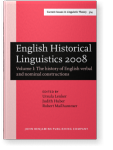Table of contents
Acknowledgements
Introduction: Capturing and explaining syntactic change in the history of English
part iVerbal constructions
“Þonne hate we hine morgensteorra”: On verb complementation in Old English
Tracking and explaining variation and change in the grammar of American English: A case study, with evidence from the TIME Corpus
Prevent and the battle of the -ing clauses: Semantic divergence?
Prescription or practice? Be/have variation with past participles of mutative intransitive verbs in the letters of Joseph Priestley
On the idiomatization of “give + O + to” constructions
The clausal complementation of good in extraposition constructions: The emergence of partially filled constructions
part iiModality and (marginal) modals
The ‘fail to’ construction in Late Modern and Present-Day English
The interplay of modal verbs and adverbs: A history of mæg eaþe
Current change in the modal system of English: A case study of must, have to and have got to
part iiiDevelopments in the English noun phrase
Discontinuous quantificational structures in Old English
Genitive variation in letters, history writing and sermons in Late Middle and Early Modern English
part ivSyntactic variation and change through contact
On the use of beon and wesan in Old English
The reflexes of OE beon as a marker of futurity in early Middle English
Stylistic fronting in the history of English
Subject and Word index
This article is available free of charge.
